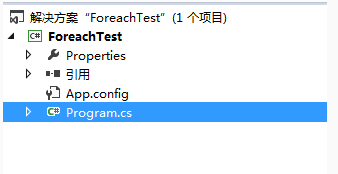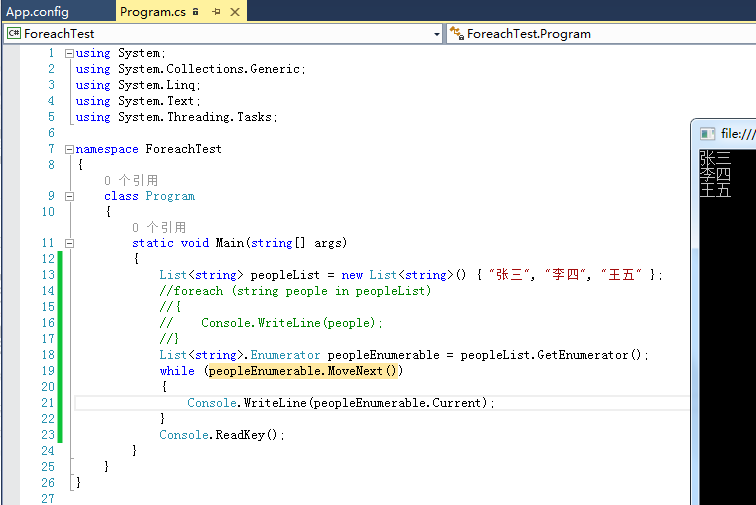C# Foreach循环本质与枚举器
对于C#里面的Foreach学过 语言的人都知道怎么用,但是其原理相信很多人和我一样都没有去深究。刚回顾泛型讲到枚举器让我联想到了Foreach的实现,所以进行一番探究,有什么不对或者错误的地方大家多多斧正。
1、创建一个控制台应用程序

2、编写测试代码并分析
在Program类中写一个foreach循环
class Program
{
static void Main(string[] args)
{
List peopleList = new List() { "张三", "李四", "王五" };
foreach (string people in peopleList)
{
Console.WriteLine(people);
}
Console.ReadKey();
}
}
生成项目将项目编译后在debug目录下用Reflection反编译ForeachTest.exe程序集后查看Program类的IL代码,IL代码如下:
.class private auto ansi beforefieldinit Program
extends [mscorlib]System.Object
{
.method public hidebysig specialname rtspecialname instance void .ctor() cil managed
{
.maxstack
L_0000: ldarg.
L_0001: call instance void [mscorlib]System.Object::.ctor()
L_0006: ret
} .method private hidebysig static void Main(string[] args) cil managed
{
.entrypoint
.maxstack
.locals init (
[] class [mscorlib]System.Collections.Generic.List`<string> list,
[] string str,
[] class [mscorlib]System.Collections.Generic.List`<string> list2,
[] valuetype [mscorlib]System.Collections.Generic.List`/Enumerator`<string> enumerator,
[] bool flag)
L_0000: nop
L_0001: newobj instance void [mscorlib]System.Collections.Generic.List`<string>::.ctor()
L_0006: stloc.
L_0007: ldloc.
L_0008: ldstr "\u5f20\u4e09"
L_000d: callvirt instance void [mscorlib]System.Collections.Generic.List`<string>::Add(!)
L_0012: nop
L_0013: ldloc.
L_0014: ldstr "\u674e\u56db"
L_0019: callvirt instance void [mscorlib]System.Collections.Generic.List`<string>::Add(!)
L_001e: nop
L_001f: ldloc.
L_0020: ldstr "\u738b\u4e94"
L_0025: callvirt instance void [mscorlib]System.Collections.Generic.List`<string>::Add(!)
L_002a: nop
L_002b: ldloc.
L_002c: stloc.
L_002d: nop
L_002e: ldloc.
L_002f: callvirt instance valuetype [mscorlib]System.Collections.Generic.List`/Enumerator`<!> [mscorlib]System.Collections.Generic.List`<string>::GetEnumerator()
L_0034: stloc.
L_0035: br.s L_0048
L_0037: ldloca.s enumerator
L_0039: call instance ! [mscorlib]System.Collections.Generic.List`/Enumerator`<string>::get_Current()
L_003e: stloc.
L_003f: nop
L_0040: ldloc.
L_0041: call void [mscorlib]System.Console::WriteLine(string)
L_0046: nop
L_0047: nop
L_0048: ldloca.s enumerator
L_004a: call instance bool [mscorlib]System.Collections.Generic.List`/Enumerator`<string>::MoveNext()
L_004f: stloc.s flag
L_0051: ldloc.s flag
L_0053: brtrue.s L_0037
L_0055: leave.s L_0066
L_0057: ldloca.s enumerator
L_0059: constrained. [mscorlib]System.Collections.Generic.List`/Enumerator`<string>
L_005f: callvirt instance void [mscorlib]System.IDisposable::Dispose()
L_0064: nop
L_0065: endfinally
L_0066: nop
L_0067: call valuetype [mscorlib]System.ConsoleKeyInfo [mscorlib]System.Console::ReadKey()
L_006c: pop
L_006d: ret
.try L_0035 to L_0057 finally handler L_0057 to L_0066
}
}
在反编译的IL代码中我们看到除了构建List和其他输出,然后多了三个方法:GetEnumerator(),get_Current() ,MoveNext() ,于是通过反编译reflector查看List泛型类,在List里面找到GetEnumerator方法是继承自接口IEnumerable 的方法,List实现的GetEnumerator方法代码
public Enumerator GetEnumerator() => new Enumerator((List) this);
即返回一个Enumerator泛型类,然后传入的参数是List泛型自己 this。接下来查看 Enumerator<T>泛型类
[Serializable, StructLayout(LayoutKind.Sequential)]
public struct Enumerator : IEnumerator<T>, IDisposable, IEnumerator
{
private List<T> list;
private int index;
private int version;
private T current;
internal Enumerator(List<T> list)
{
this.list = list;
this.index = ;
this.version = list._version;
this.current = default(T);
} public void Dispose()
{
} public bool MoveNext()
{
List<T> list = this.list;
if ((this.version == list._version) && (this.index < list._size))
{
this.current = list._items[this.index];
this.index++;
return true;
}
return this.MoveNextRare();
} private bool MoveNextRare()
{
if (this.version != this.list._version)
{
ThrowHelper.ThrowInvalidOperationException(ExceptionResource.InvalidOperation_EnumFailedVersion);
}
this.index = this.list._size + ;
this.current = default(T);
return false;
} public T Current =>
this.current;
object IEnumerator.Current
{
get
{
if ((this.index == ) || (this.index == (this.list._size + )))
{
ThrowHelper.ThrowInvalidOperationException(ExceptionResource.InvalidOperation_EnumOpCantHappen);
}
return this.Current;
}
}
void IEnumerator.Reset()
{
if (this.version != this.list._version)
{
ThrowHelper.ThrowInvalidOperationException(ExceptionResource.InvalidOperation_EnumFailedVersion);
}
this.index = ;
this.current = default(T);
}
}
我们看到这个Enumerator<T>泛型类实现了接口IEnumerator的方法,也就是我们测试的ForeachTest程序集反编译后IL代码中出现的get_Current() ,MoveNext() 方法。所以foreach实际上是编译器编译后先调用GetEnumerator方法返回Enumerator的实例,这个实例即是一个枚举器实例。通过MoveNext方法移动下标来查找下一个list元素,get_Current方法获取当前查找到的元素,Reset方法是重置list。
3、总结
因此要使用Foreach遍历的对象是继承了IEnumerable接口然后实现GetEnumerator方法。返回的实体对象需要继承IEnumerator接口并实现相应的方法遍历对象。因此Foreach的另一种写法如下。

最新文章
- Linux kilin 安装和按键服务器步骤
- [AngularJS] AngularJS系列(5) 中级篇之动画
- 加州大学伯克利分校Stat2.3x Inference 统计推断学习笔记: Section 3 One-sample and two-sample tests
- C#基础知识大杂烩
- 二叉树系列 - 二叉搜索树 - 线性时间内把有序链表转化为BST
- iOS蓝牙4.0开发(BLE)
- 设计模式(十三): Proxy代理模式 -- 结构型模式
- 国内PaaS概述和EEPlat定位
- windows 注入 之 CreateRemoteThread
- 初版python计算器
- Bugku 杂项 啊哒
- maven的依赖特性
- HDU - 6305 RMQ Similar Sequence(笛卡尔树)
- easyui的combobox,自动搜索的下拉框
- JavaScript.how-to-debug-javascript
- 快排法求第k大
- jmeter写好的脚本检查无误之后就是无法执行成功
- Node.js模块封装及使用
- ConnectivityManager详解
- 算法笔记_087:蓝桥杯练习 9-1九宫格(Java)
热门文章
- 解决subline安装插件被墙失败的方法
- 对于synchronized的理解
- #umn 来美国近一个月的简单见闻
- Python3实战Spark大数据分析及调度 (网盘分享)
- Winform中实现ZedGraph曲线图的图像复制到剪切板、打印预览、获取图片并保存、另存为的功能
- hive内部表与外部表区别详细介绍
- error LNK1104: 无法打开文件“opencv_world331.lib” LINK : fatal error LNK1104: 无法打开文件“opencv_world331.lib”,程序报这个错误时应该怎么解决?
- Git服务端下载
- 38 (OC)* 进程、线程、堆栈
- PiVot 用法